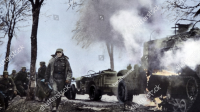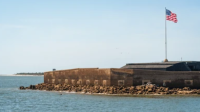Introduction: One of WWII’s Darkest Moments
The Bataan Death March of 1942 stands as one of the most harrowing and tragic events of World War II. After the fall of the Bataan Peninsula in the Philippines, American and Filipino troops were forced by Japanese soldiers to march over 60 miles in grueling conditions. Thousands of soldiers died along the way from exhaustion, starvation, dehydration, and brutal treatment. This event has left a deep scar in history, symbolizing both the brutality of war and the resilience of those who survived.
Read Also : The Waco Siege (1993): A Tragic Confrontation Between Government and Cult
The Fall of Bataan: Prelude to the March
The fall of Bataan marked a devastating defeat for Allied forces and set the stage for the infamous death march. After months of fierce fighting, Allied troops—primarily composed of American and Filipino soldiers—were overwhelmed by the Japanese forces.
The Battle for Bataan
The battle for Bataan was a grueling struggle that lasted from January to April 1942. Allied forces, including the USAFFE (United States Army Forces in the Far East), attempted to hold off the Japanese invasion in the Philippines. Despite their determination, the Allied soldiers were outnumbered, outgunned, and severely undersupplied. As the Japanese offensive intensified, the Allies found themselves pushed into a defensive position on the Bataan Peninsula.
The soldiers on Bataan endured harsh conditions. Supplies were critically low, and many troops suffered from hunger, disease, and exhaustion. The jungle terrain and constant Japanese attacks made life on the frontlines unbearable. By early April, the situation had become hopeless, and General Edward King, the commanding officer of the forces in Bataan, made the difficult decision to surrender to the Japanese.
Ultimately, despite their bravery and resilience, the Allied forces could not overcome the overwhelming odds they faced. The surrender, while necessary, marked the beginning of a nightmare for the soldiers who had fought so valiantly to defend the Philippines from Japanese occupation.
General Edward King’s Decision to Surrender
On April 9, 1942, Major General Edward King made the agonizing decision to surrender the remaining 75,000 troops in Bataan to the Japanese. This surrender marked the largest American military capitulation in history. General King made this difficult choice because his troops were starving, diseased, and without reinforcements. They had fought bravely, but they could no longer continue.
King’s decision was motivated by a desire to save his soldiers from further bloodshed. However, he could not have predicted the horror that awaited his men. The Japanese, unprepared for such a large number of prisoners, were brutal in their treatment of the captives. What followed was one of the most notorious war crimes of World War II—the Bataan Death March.
In hindsight, King’s surrender, while necessary to avoid total annihilation, led to unimaginable suffering for the men who had trusted him. The surrender was supposed to mark the end of their ordeal, but instead, it was only the beginning of a new chapter of torment and death for the captured soldiers.
The Conditions Leading to the Surrender
The conditions leading up to the surrender of Bataan were dire. The Allied forces had been cut off from resupply and reinforcement for months. They faced not only the relentless Japanese forces but also tropical diseases such as malaria and dysentery, which ravaged the troops. Hunger was rampant, and many soldiers were weakened to the point of collapse.
The troops were surviving on meager rations, often eating little more than rice, with few medical supplies to treat their illnesses and injuries. Desperation had set in among the ranks, with many soldiers too weak to fight. Despite these hardships, they held out for as long as possible, knowing the strategic importance of Bataan.
By the time General King made the decision to surrender, many soldiers were bedridden, suffering from severe malnutrition, and barely able to stand. The situation was beyond hope, and the surrender, while tragic, was necessary to prevent the complete annihilation of the remaining troops.
The Brutal March Begins
Once the Allied forces in Bataan surrendered, the Japanese wasted little time in beginning the forced relocation of prisoners. The journey that would come to be known as the Bataan Death March started almost immediately, and it quickly became clear that it would be a march of unimaginable suffering.
The Start of the March
The march began on April 10, 1942, when the first groups of prisoners were ordered to begin their journey north from Mariveles on the southern tip of the Bataan Peninsula. The prisoners were divided into groups and forced to march approximately 60 miles to San Fernando. From there, they would be transported by rail to Camp O’Donnell, a prison camp in Capas, Tarlac.
The conditions were horrific from the outset. The prisoners, already weakened by months of battle, were forced to march in the searing tropical heat with little to no food or water. Many of them collapsed from exhaustion or dehydration, only to be beaten or bayoneted by the Japanese guards. The march quickly became a death march, as soldiers died by the thousands along the way.
The route was littered with the bodies of fallen soldiers, and the prisoners were subjected to constant abuse by the Japanese guards. The guards showed little mercy, often shooting or stabbing those who fell behind. For many of the soldiers, the march was a test of sheer willpower, as they pushed their bodies beyond the limits of endurance.
The Role of Japanese Guards in the March
The Japanese soldiers overseeing the march were notorious for their brutality. They viewed the prisoners as dishonorable for surrendering and treated them with disdain. The Japanese philosophy of bushido, which emphasized honor in battle, did not condone surrender, and the guards reflected this in their harsh treatment of the prisoners.
The guards frequently beat the prisoners with rifle butts or bamboo sticks, and they showed no sympathy for those who were sick or wounded. Many soldiers who collapsed from exhaustion or illness were executed on the spot. The prisoners were denied basic necessities such as food and water, and any attempt to help a fellow soldier was often met with violence.
Despite the inhumane treatment, some of the Japanese guards took pity on the prisoners, providing them with small amounts of water or food when they could. These acts of kindness, however, were rare, and the overwhelming majority of the guards enforced a regime of cruelty and terror.
Filipino Civilians’ Acts of Kindness
Along the route of the march, Filipino civilians risked their lives to help the prisoners. Despite the dangers of Japanese retribution, many civilians offered food, water, and even shelter to the soldiers. These acts of kindness were small gestures, but they meant the difference between life and death for many of the prisoners.
The Filipino civilians understood the suffering of the Allied soldiers and sympathized with their plight. They knew that aiding the prisoners could result in punishment or execution by the Japanese, but their compassion drove them to help in whatever way they could. This solidarity between the Filipino people and the Allied soldiers became a lasting symbol of resistance and hope in the face of brutality.
The acts of bravery by Filipino civilians did not go unnoticed by the prisoners. Many survivors of the march later spoke of the gratitude they felt for the people who risked everything to offer a moment of relief in the midst of unimaginable suffering. Their actions exemplified the strength of the human spirit and the bonds of solidarity that emerged during one of the darkest chapters of the war.
Camp O’Donnell: The Final Destination
After enduring days of unimaginable suffering, the surviving prisoners finally reached their destination—Camp O’Donnell. However, their ordeal was far from over, as the conditions in the camp were as deadly as the march itself.
Arrival at Camp O’Donnell
Camp O’Donnell was a former Philippine Army training facility that had been converted into a Japanese prison camp. Upon arrival, the prisoners were met with overcrowded conditions, limited food and water, and a complete lack of medical care. The camp was ill-equipped to handle the thousands of prisoners that had survived the march, and disease spread rapidly through the ranks.
The arrival at Camp O’Donnell offered little relief for the soldiers who had made it through the march. The camp was a breeding ground for disease, and many prisoners were already suffering from severe dehydration and malnutrition. The lack of proper sanitation and medical care meant that illnesses such as dysentery, malaria, and beriberi ran rampant, leading to a high death toll among the prisoners.
The Japanese guards continued their harsh treatment of the prisoners within the camp, with executions and beatings being commonplace. The combination of disease, starvation, and mistreatment made Camp O’Donnell a living hell for those who had survived the death march.
Life Inside the Camp
Life inside Camp O’Donnell was a constant struggle for survival. The prisoners were given only small rations of food, usually rice or thin soup, which was not enough to sustain them after the grueling march. Clean drinking water was scarce, and the prisoners often had to drink from contaminated sources, leading to further outbreaks of disease.
The camp was overcrowded, with thousands of prisoners crammed into small spaces with inadequate shelter. The lack of hygiene and proper facilities exacerbated the spread of disease, and the camp’s hospital was little more than a place where sick prisoners were left to die. Medical supplies were virtually non-existent, and the camp’s doctors could do little to alleviate the suffering of the men under their care.
Despite the horrific conditions, the prisoners did their best to maintain their morale. Some formed close bonds with their fellow soldiers, offering each other support and companionship in the face of overwhelming adversity. These small acts of solidarity helped many survive the brutal conditions of the camp, even as thousands around them perished.
The Death Toll at Camp O’Donnell
The death toll at Camp O’Donnell was staggering. Of the approximately 75,000 prisoners who began the Bataan Death March, it is estimated that between 5,000 and 10,000 died along the way. Thousands more died in the camp, succumbing to disease, starvation, and the harsh treatment of their captors.
The death toll among Filipino soldiers was particularly high, as they received even less food and medical care than their American counterparts. The exact number of deaths at Camp O’Donnell may never be known, but it is clear that the camp was one of the deadliest prison camps of World War II.
The Bataan Death March and the horrors of Camp O’Donnell left a lasting legacy of suffering and loss. For those who survived, the memories of the march and the camp would haunt them for the rest of their lives. The survivors would go on to share their stories, ensuring that the world would never forget the atrocities they endured.
The Legacy of the Bataan Death March
The Bataan Death March remains one of the most tragic and significant events of World War II. It left a profound impact on both the Philippines and the United States, shaping the way the war was remembered and influencing relations between the two nations for years to come.
War Crimes Trials and Justice
After the war, the Bataan Death March was recognized as a war crime, and several Japanese officers were held accountable for their actions. The most prominent of these was General Masaharu Homma, who was in charge of the Japanese forces during the march. He was tried for war crimes and found guilty, ultimately being executed by firing squad in 1946.
The war crimes trials were an important step toward justice, but they could never fully compensate for the suffering endured by the men who survived the march. For many of the survivors, the trials provided some sense of closure, but the memories of the march and the friends they lost would stay with them forever.
The legacy of the Bataan Death March continues to serve as a reminder of the horrors of war and the importance of holding those who commit atrocities accountable for their actions. The trials marked an important moment in the post-war period, as the world sought to ensure that such crimes would never be repeated.
Memorials and Remembrance
In the years following the war, memorials were erected to honor the memory of those who died during the Bataan Death March. In the Philippines, April 9 is recognized as Araw ng Kagitingan (Day of Valor), a national holiday that commemorates the bravery of the Filipino and American soldiers who fought and died in Bataan. Ceremonies and events are held each year to honor the sacrifices made during the war.
In the United States, memorials and monuments have been built to honor the survivors of the Bataan Death March. Survivors’ stories have been recorded and preserved in museums and archives, ensuring that future generations will never forget the sacrifices made by those who endured the march.
The legacy of the Bataan Death March is one of both tragedy and resilience. The soldiers who survived demonstrated incredible strength and courage in the face of unimaginable hardship, and their stories continue to inspire people around the world.
Conclusion: Remembering the Bataan Death March
The Bataan Death March stands as a grim reminder of the brutal realities of war. The event encapsulates the immense suffering endured by both American and Filipino soldiers as they were forced to march through treacherous conditions with little food, water, or medical care. The atrocities committed during the march and within Camp O’Donnell are a stark example of the darker aspects of humanity during times of conflict. However, the resilience of those who survived, and the acts of bravery and kindness by Filipino civilians, also highlight the enduring strength of the human spirit. The legacy of the Bataan Death March continues to be remembered through memorials, historical accounts, and national commemorations, serving as a testament to the sacrifices made and a lesson on the importance of justice in the aftermath of war.
FAQ
What was the Bataan Death March?
The Bataan Death March was a forced relocation of approximately 75,000 Filipino and American soldiers by the Japanese army after the fall of the Bataan Peninsula during World War II. The soldiers were forced to march over 60 miles under brutal conditions, resulting in thousands of deaths.
Why did the Bataan Death March happen?
The Bataan Death March occurred after the surrender of Allied forces in the Philippines to the Japanese in 1942. The Japanese army was unprepared to handle such a large number of prisoners and forced them to march to prison camps under harsh conditions as part of their relocation.
How many soldiers died during the Bataan Death March?
Estimates vary, but it is believed that between 5,000 and 10,000 Filipino and American soldiers died during the march itself. Thousands more perished later in Japanese prison camps due to starvation, disease, and mistreatment.
What happened to the soldiers who survived the march?
The soldiers who survived the march were taken to Japanese prison camps, such as Camp O’Donnell, where many continued to suffer from disease, starvation, and harsh treatment. Thousands more died in the camps before they were eventually liberated by Allied forces.
How is the Bataan Death March remembered today?
The Bataan Death March is commemorated every year on April 9 as Araw ng Kagitingan (Day of Valor) in the Philippines. In the United States and the Philippines, memorials and monuments honor the memory of those who suffered and died, and survivors’ stories are preserved in museums and archives.







Pretty nice post. I simply stumbled upon your blog and wished to say that I have truly enjoyed surfing around your blog posts. In any case I will be subscribing in your rss feed and I’m hoping you write once more very soon!
I don抰 even know how I ended up here, but I thought this post was great. I don’t know who you are but certainly you’re going to a famous blogger if you aren’t already 😉 Cheers!